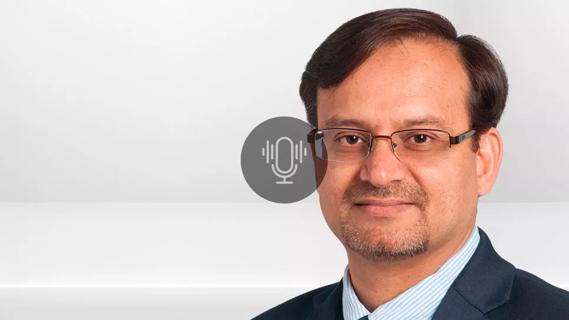For the approximately 20-30% of Hodgkin’s lymphoma (HL) patients with relapsed or refractory disease, physicians typically prescribe a high-dose chemotherapy conditioning regimen followed by autologous hematopoietic stem cell transplantation. This treatment is considered standard of care for these patients, to increase the likelihood of optimal outcome.
Cleveland Clinic is a non-profit academic medical center. Advertising on our site helps support our mission. We do not endorse non-Cleveland Clinic products or services. Policy
A new comparison of two commonly used high-dose conditioning regimens for HL shows the choice could have a significant effect on survival and likelihood of relapse, with a clear advantage for the BEAM (carmustine, etoposide, cytarabine, and melphalan) regimen versus BUCYVP16 (busulfan, cyclophosphamide, and etoposide), especially for higher-risk patients who required transplant within 24 months from diagnosis, or who had an incomplete response to treatment prior to autologous transplantation.
There was no significant difference in overall toxicity between the two treatments, except for high rates of mucositis and longer hospitalization in patients who received BUCYVP16, the retrospective study found. Those patients required significantly longer hospital stays on average than patients treated with BEAM, probably because of a longer time to achieve adequate oral intake after mucositis.
The results of the study — a research collaboration between Cleveland Clinic’s Department of Hematology and Oncology and The Ohio State University Comprehensive Cancer Center — were so compelling that Cleveland Clinic clinicians replaced BUCYVP16 with BEAM for frontline conditioning of patients with relapsed HL.
“We’ve moved to the BEAM regimen across the board now for our Hodgkin’s patients, because even in the subgroup analyses in the study we conducted with the Ohio State group, we didn’t find any group of patients who did better with the busulfan-based regimen,” says Robert Dean, MD, a physician in Cleveland Clinic Cancer Center’s Department of Hematology and Medical Oncology and co-author of the study.
The findings support BEAM as a standard of care against which other conditioning regimens for Hodgkin’s lymphoma should be measured, Dr. Dean and his research collaborators conclude.
Interestingly, a previous study by the same group comparing BEAM and BUCYVP16 conditioning in relapsed non-Hodgkin’s lymphoma patients did not show a significant difference in outcomes. Therefore, this patient population continues to receive the busulfan-based regimen at Cleveland Clinic.
“The non-Hodgkin’s lymphoma patients seem to do just as well with one regimen versus the other,” Dr. Dean says. “Institutionally, we’ve invested a lot of time in refining that regimen and continue to work on improving it for these patients.”
The latest HL findings build on a 2016 multicenter study that suggested a survival benefit with the BEAM approach in HL patients. Cleveland Clinic was peripherally involved in that initial research.
In the current study, Dr. Dean and colleagues retrospectively assessed the outcomes of 128 patients who underwent conditioning with BEAM and another 105 treated with the busulfan-based regimen. The 5-year cumulative relapse incidence was 29% in the BEAM group versus 56% with the busulfan-treated patients, a significant difference.
Median follow-up was 3.8 years in the BEAM patients and 4.2 years in the busulfan patients. Median progression-free survival and overall survival rates were not reached for the BEAM group at the time of publication; they were 2 years and 7.8 years with the busulfan regimen, respectively.
For those patients who required transplantation within 24 months of diagnosis, and for patients not in complete remission at the time of stem cell transplantation, the BEAM regimen was associated with significantly improved progression-free survival (p < .001) and overall survival (p = .001), the researchers found.
“That was a game-changer for us,” Dr. Dean says. “When we saw the data from our two institutions confirming the findings of the earlier, external study, we quickly moved to change our practice, which had been using the busulfan-based regimen for our Hodgkin’s patients.”
Cleveland Clinic remains a leader in cancer care because of a commitment to critically review patient care practices on an ongoing basis, Dr. Dean says. Whether it is retrospective research evaluating outcomes or prospective studies assessing novel ways to treat patients, “we always have to be on the lookout for something that could serve our patients better than we are currently doing.”
“Looking critically at our results and working to get better is intrinsic to what we do and what we should be doing as a leading cancer center and as researchers in the field of lymphoma and transplantation,” Dr. Dean says.
As an example, Cleveland Clinic researchers Brian Hill, MD, PhD, and Allison Winter, MD, are enrolling patients with non-Hodgkin’s lymphoma in a new study to evaluate the efficacy of the BEAM-based conditioning regimen when combined with the antineoplastic drug venetoclax.

First-of-its-kind research investigates the viability of standard screening to reduce the burden of late-stage cancer diagnoses

Study demonstrates ability to reduce patients’ reliance on phlebotomies to stabilize hematocrit levels

Findings highlight an association between obesity and an increased incidence of moderate-severe disease

Cleveland Clinic Cancer Institute takes multi-faceted approach to increasing clinical trial access

Key learnings from DESTINY trials

Gene editing technology offers promise for treating multiple myeloma and other hematologic malignancies, as well as solid tumors

Study of 401,576 patients reveals differences in cancer burdens as well as overall survival

Enfortumab plus pembrolizumab reduced risk of death by 53% compared with platinum-based chemotherapy